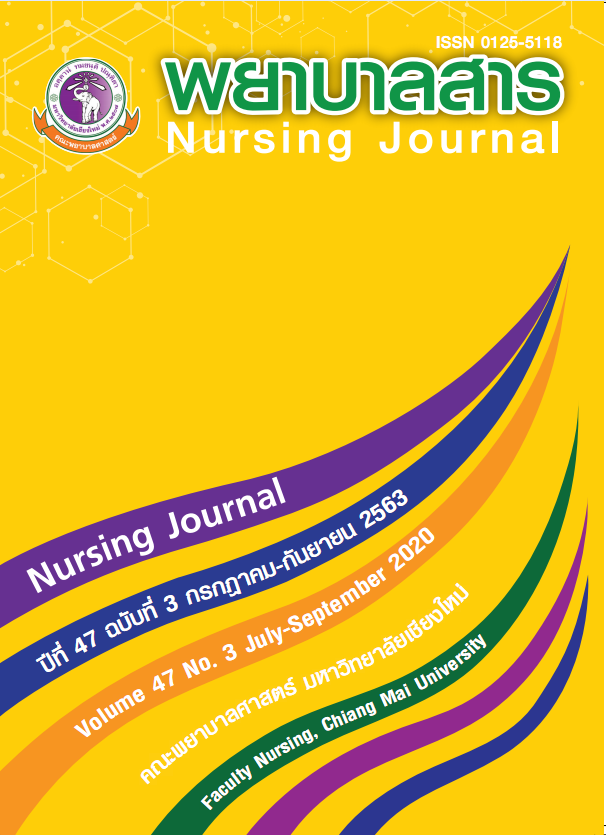Factors Discriminating Overweight and Normal Weight Among Troops in the 4th Infantry Brigade
Keywords:
Overweight, Normal weight, Ecological Model,, TroopsAbstract
Overweight and obesity are public health problems in Thailand. Overweight and obesity rates among adults have continuously increased. This descriptive research aimed to explore the factors discriminating the overweights and the normal weights among troops in the 4th Infantry Brigade Phitsanulok Province. The sample was the soldiers whose body was normal weight or overweight. The 288 troops were classified as 147 overweight troops and 141 normal weight troops, using stratified random sampling. The research instrument was a questionnaire, applied in ecological model. The Content validity was reviewed by 5 experts, and the index of Item Objective Congruence (IOC) was between 0.60 to 1.00. The reliability of knowledge on the overweights was 0.74, tested by Kuder-Richardson (KR20). The questionnaire on intrapersonal, interpersonal and organization factors were tested for understanding and appropriate language. The data was analyzed by descriptive statistics and discriminant analysis (stepwise technique).
The results showed that five factors that could discriminate the overweights and the normal weights of the troops were workplace environment, Eating behavior, Job description, exercise behavior and Age. They could predict the accuracy of the classification in 2 groups at the percentage of 58.3.
The results of this research can be used as information for promoting workplace environment, conduct projects or activities related to food consumption and exercise to prevent from and overcome the overweight of the troops.
References
Best, J. W. (1981). Research in education. New Jersey: Prentice Hall.
Bloom, B. S. (1971). Hand book on formative and summative evaluation of student learning. New York: Mc Graw-Hill.
Boonsan, M., Kasipol, T., & Durongritichai, V. (2014). Factors predicting health behaviors on nutrition and exercise among Royal Thai Army Military with metabolic syndrome at Nawamintharachini Fort. Chon buri province. Journal of The Royal Thai Army Nurses, 15 (2), 312-319. (In Thai)
Chaitokgia, S. (2018). Factors affecting food consumption behaviors of adults in northeast Thailand.Research and Development Journal. Loei Rajabhat University, 3 (45), 68-78. (In Thai)
Jeong, U. L., Jae, H. L., Ju. S. K., Yong, I. H., Tae, H. K., Seong, Y. L., … Chin, K. R., (2017). Comparison of world health organization and asia-pacific body mass index cl assifications in COPD patients. Int J Chron Obstruct Pulmon Dis, 12, 2465-2475
Karoonngamphan, M., Suvaree, S., & Numfone, N. (2012). Health b ehaviors and health status of workers: A case study of workplaces in Sathorn district, Bangkok metropolitan. Songklanagarind Journal of Nursing, 32 (3), 51-66. (In Thai)
Kraipibul, P. (2019). Obesity and overweight. Retrieved from http://haamor.com/th/ (In Thai)
Krejcie, R. V., & Morgan, D. W. (1970). Determining sample size for research activities. Educational and Psychological Measurement, 30, 607-610.
Kuder, F. G. & Richardson, M. W. (1937). The theory of the esti mation of test reliability.Psychometrika, 2, 151-160.
Linlawan, S. (2011). Incidence and risk factors of metabolic sy ndrome in personnel ofPhrachomklao hospital. Region 4-5 Medical Journal, 30(3), 249-259. (In Thai)
Mahachote, L. (2014). Factors influencing body weight control behaviors of aerobics club memberin mueang district. Nakhon pathom province. Retrieved from http://www.thapra.lib.su.ac.th/(In Thai)
Mansiri, R., Oba, N., & Naewbood, S. (2016). Effects of self-efficacy program on weight controlbehaviors and body mass Index of obese students. Journal of Nursing and Health Sciences, 10 (3), 145-158. (In Thai)
McLeroy, K. R., Bibeau, D., Steckler, A., & Glanz, K. (1988). An ecological perspective on healthpromotion programs. Health Education Quarterly, 15 (4), 351-377.
Na Thalang, R., Damrongsak, M., & Wattana, C. (2014). The factors influencing the development of metabolic syndrome among the personnel of a private higher-education Institution. Nursing Journal, 41 (3), 83-93. (In Thai)
Pantaewan, P. (2017). Ecological model and health behavior chan ge. Journal of The Royal Thai Army Nurses, 18 (2), 7-15. (In Thai)
Pudcharakuntana, P. Khungtumneam, K., & Durongritichtichai, V., (2015). The factors asociated to the prevalence of obesity in adults in bang sao thong municipality, samuth prakan province.Journal of The Royal Thai Army Nurses, 16 (2), 131-139. (In Thai)
Ravinit, P., & Sattam, A. (2016). Factor associated with the metabolic syndrome in Chamab sub-district. Wang Noi district. Ayutthaya province. APHEIT Jounals, 5(2), 33-47. (In Thai)
Royal Thai Army. (2012). Army Regulation: Army personnel performance evaluation. Retrieved from https://dop.rta.mi.th/. (In Thai)
Saiphiroonthong, W., Choaksuwankij, C., & Chaimanee, A. (2015). The association between sedentary work and obesity among medical personnel in Nopparat Rajathanee hospital. The Public Health Journal of Burapha University, 10(2), 34-43. (In Thai)
Strategy and Planning Division. (2013). Statistical Thailand 2013. Retrieved from http://bps.moph.go.th/new_bps/sites/default/files/statistical2556.pdf. (In Thai)
Srisatidnarakul, B. (2010). The methodology in nursing research. Bangkok: U and I-intermedia-co-ltd. (In Thai)
Thamarangsi, T. (2014). Obesity epidemic: costly harms to every individual. Health PromotionPolicy Unit. International Health Policy Program. Bangkok: Ministry of Public Health. (In Thai)
World Health Organization [WHO]. (2016). Obesity and overweight. Retrieved fromhttps://www.who.int/.
Downloads
Published
How to Cite
Issue
Section
License
บทความที่ได้รับการตีพิมพ์เป็นลิขสิทธิ์ของวารสารพยาบาลสาร
ข้อความที่ปรากฏในบทความแต่ละเรื่องในวารสารวิชาการเล่มนี้เป็นความคิดเห็นส่วนตัวของผู้เขียนแต่ละท่านไม่เกี่ยวข้องกับมหาวิทยาลัยเชียงใหม่ และคณาจารย์ท่านอื่นๆในมหาวิทยาลัยฯ แต่อย่างใด ความรับผิดชอบองค์ประกอบทั้งหมดของบทความแต่ละเรื่องเป็นของผู้เขียนแต่ละท่าน หากมีความผิดพลาดใด ๆ ผู้เขียนแต่ละท่านจะรับผิดชอบบทความของตนเองแต่ผู้เดียว






